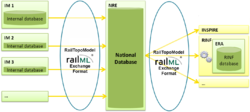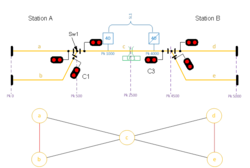RTM quick start: Difference between revisions
Jump to navigation
Jump to search
| [checked revision] | [checked revision] |
No edit summary |
Ferri Leberl (talk | contribs) (Änderung Navi) |
||
| (30 intermediate revisions by 4 users not shown) | |||
| Line 1: | Line 1: | ||
{{ | == {{rtm}} For Your Business == | ||
{{ | [[File:IdealSituationNew.png|thumbnail|250px|Ideal national situation with the {{rtm}} and {{rml}} (© IIRC)]] | ||
In this section you will find answers to the question why you should use the {{rtm}} for your specific data modelling and exchange problem. See [[RTM For Your Business]] for more details.<br /> | |||
<br /> | |||
<br /> | |||
<br /> | |||
== | |||
== {{rtm}} For IT Architects and Developers == | |||
[[File:SampleNetwork1.png|thumbnail|250px|Simple Sample Network Part 1]] | |||
This section addresses the software developers of the companies that want to implement a {{rtm}} based asset database. A simple example shows how to get from the real infrastructure to the {{rtm}} representation. See [[RTM for IT Architects and Developers]] for more details. | |||
{{navi | |||
|chapterlink=RTM quick start | |||
|nextlink=RTM for your business | |||
|chapter={{RTM}} quick start | |||
|next={{RTM}} for your business | |||
|lesson=This page is just a quick introduction | |||
|nchapter={{rtm}} Modelling Concepts | |||
|nchapterlink=RTM Modelling Concepts | |||
|section= | |||
}} | |||
Latest revision as of 14:37, 13 March 2017
RailTopoModel® For Your Business
In this section you will find answers to the question why you should use the RailTopoModel® for your specific data modelling and exchange problem. See RTM For Your Business for more details.
RailTopoModel® For IT Architects and Developers
This section addresses the software developers of the companies that want to implement a RailTopoModel® based asset database. A simple example shows how to get from the real infrastructure to the RailTopoModel® representation. See RTM for IT Architects and Developers for more details.
| What you should have learned | |||
|---|---|---|---|
| This page is just a quick introduction | |||
| Navigation | |||
| Home | ← | • | → |
| Chapter | RailTopoModel® quick start | RailTopoModel® Modelling Concepts | |
| Section | RailTopoModel® for your business | ||
| Subection | |||

